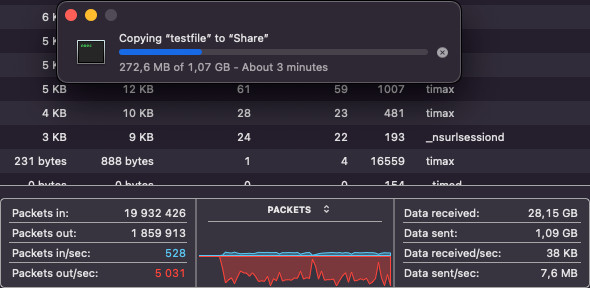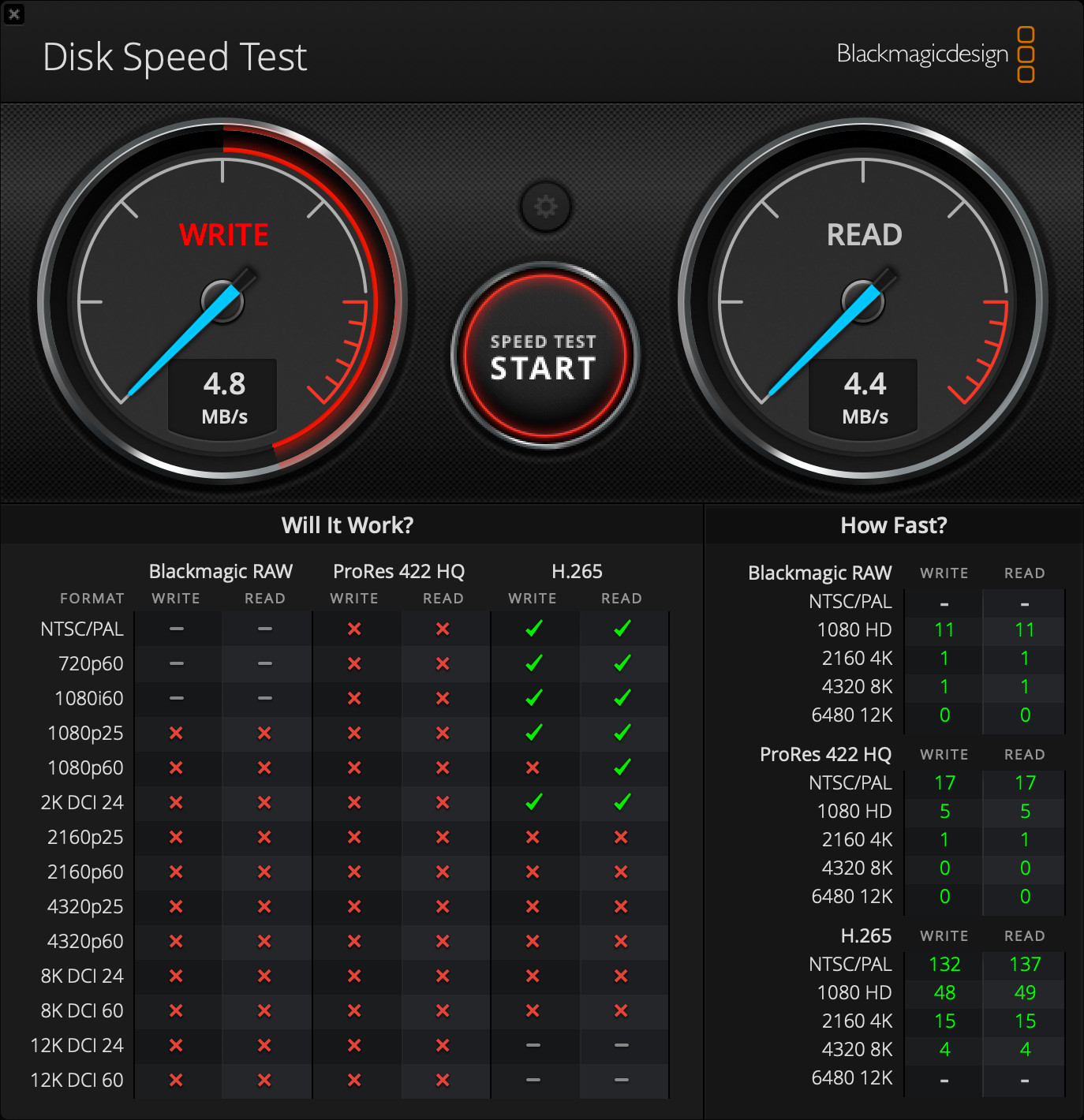This is the fourth part of the Raspberry Pi Zero 2W-based Storage Server Shenanigans.

In this series, I’m transforming a Raspberry Pi Zero 2W into a super cheap storage server wannabe!
If you want to catch up on what I’ve done so far, check out the previous parts:
- P1: Custom Case & Hardware
- P2: Overclocking & Power Usage
- P3: Drive Performance
- P4: Mdadm and Samba (current)
- P5: OpenMediaVault
I’ve also made a YouTube video that showcases the project:
Part Four: mdadm & Samba
In this blog post, we’re finally gonna configure a bare-bones network attached storage server running RAID array. We’re gonna do this with the help of mdadm and Samba. We’ll look at some popular RAID options, set them up, and test their performance. Then we’ll configure Samba for file sharing and finally test if the network transfer speeds match the local read/write speeds.
As with the previous part, I’m writing this blog post as I go. This is to show you the exact commands I’m using and to spare myself the trouble of trying to remember how I did things later. That said, I don’t know the outcome yet, so you’ll have to read along to see how it turns out.
mdadm
mdadm is a Linux utility for creating software RAID arrays. Linux has a so-called “multiple devices” driver that handles software RAID without the need for any hardware RAID cards. We’re gonna use this combo to create a RAID array on some flash drives.
A minor note here: I used to develop mdadm for a living. I did it for over 3 years: two years as an intern, and the rest as a full-time “System Software Development Engineer” at Intel. Good old times.
Installing mdadm?
While mdadm can be installed from the Debian repositories, that version is seriously outdated. You don’t have to take my word for it, let me prove it.
timax@pistorage:~ $ sudo apt install mdadm
[...]
timax@pistorage:~ $ mdadm --version
mdadm - v4.2 - 2021-12-30 - Debian 4.2-5
Let’s remove that version and compile mdadm ourselves.
timax@pistorage:~ $ sudo apt remove mdadm
Compiling mdadm
Let’s clone mdadm from the official repository on GitHub.
timax@pistorage:~ $ sudo apt install git
[...]
timax@pistorage:~ $ git clone https://github.com/md-raid-utilities/mdadm.git
Cloning into 'mdadm'...
[...]
timax@pistorage:~ $ cd mdadm/
Now let’s check out the latest stable tag.
timax@pistorage:~/mdadm $ git checkout mdadm-4.4
Before we compile the utility, we need to install some required packages. The list can be found in the README in the mdadm repo.
timax@pistorage:~/mdadm $ sudo apt install pkg-config gcc make libudev-dev
Once that’s done, mdadm can be compiled and installed with the following command.
timax@pistorage:~/mdadm $ sudo make -j$(nproc) install install-systemd
[...]
timax@pistorage:~/mdadm $ mdadm --version
mdadm - v4.4 - 2024-12-13
Creating RAID arrays
We’ll create and benchmark the most popular RAID levels: 0, 1, 5, and 10. Note that we’re limited here by the bandwidth of the USB hub the drives are connected to. I expect much worse performance than what we saw when benchmarking bare drives.
Note: I won’t go into detail about the RAID levels. This blog isn’t meant to be a tutorial base. If you’re interested in that topic, you can get up to speed on RAID via Wikipedia.
RAID 0
The RAID 0 array was created using the following command snippet:
timax@pistorage:~/mdadm $ sudo mdadm --create /dev/md/raid0 --run --level=0 --raid-devices=4 --assume-clean /dev/sd*
Although the --assume-clean flag is redundant for RAID 0, I included it for consistency. This way, only the device name and RAID level need to change for other configurations.
timax@pistorage:~/mdadm $ cat /proc/mdstat
Personalities : [raid0]
md127 : active raid0 sdd[3] sdc[2] sdb[1] sda[0]
423141888 blocks super 1.2 512k chunks
unused devices: <none>
timax@pistorage:~/mdadm $ lsblk
NAME MAJ:MIN RM SIZE RO TYPE MOUNTPOINTS
sda 8:0 1 57.7G 0 disk
`-md127 9:127 0 403.5G 0 raid0
sdb 8:16 1 57.7G 0 disk
`-md127 9:127 0 403.5G 0 raid0
sdc 8:32 1 57.7G 0 disk
`-md127 9:127 0 403.5G 0 raid0
sdd 8:48 1 230.5G 0 disk
`-md127 9:127 0 403.5G 0 raid0
mmcblk0 179:0 0 28.8G 0 disk
|-mmcblk0p1 179:1 0 512M 0 part /boot/firmware
`-mmcblk0p2 179:2 0 28.3G 0 part /
In RAID 0, data is split into smaller chunks (stripes) and distributed across all drives. This means that during read/write operations, all drives should (in theory) be used sequentially and frequently. I’ve already created a partition and a filesystem on the RAID array, so let’s take a look at the benchmark results.
We’ll use the same fio command for all benchmarks, changing only the --rw and --name parameters.
sudo fio --name=write_test --filename=/mnt/testfile --size=1G --bs=4k --rw=write --direct=1 --numjobs=1 --output-format=json
Benchmark Results
Here are the results.
| Direction | Avgr. Write Speed (Megabytes per second) | 0.01% latency (ms) |
|---|---|---|
| Write | 2,183 | 893,38 |
| Read | 6,118 | 70,77 |
- Average write speed is based on the
bw_bytesparameter fromfio. - Latency is taken from the 99.99th percentile in the
fiooutput.
To be honest, I expected much worse. I thought sequential read would doom any performance, but seems it does not really matter.
Next, let’s stop the array and remove the RAID metadata from the drives to prepare for the next setup.
timax@pistorage:~/logs $ sudo mdadm --stop /dev/md127
mdadm: stopped /dev/md127
timax@pistorage:~/logs $ sudo mdadm --zero-superblock /dev/sd*
RAID 1
Here are the results for RAID 1:
| Direction | Average Write Speed (MB/s) | 99.99th Percentile Latency (ms) |
|---|---|---|
| Write | 0.891 | 2634.02 |
| Read | 6.088 | 21.36 |
Well, my only comment is that I thought it would be worse. The available space isn’t great either.
…but hey, if our cheapo flash drives die, we’ve got 4 copies of the data.
RAID 5
Let’s see how RAID 5 is managing.
| Direction | Average Write Speed (MB/s) | 99.99th Percentile Latency (ms) |
|---|---|---|
| Write | 0.928 | 2399.14 |
| Read | 5.986 | 67.63 |
Well, not much better.
RAID 10
RAID 10?
| Direction | Average Write Speed (MB/s) | 99.99th Percentile Latency (ms) |
|---|---|---|
| Write | 1.333 | 2365.58 |
| Read | 6.030 | 88.6 |
Well, a bit better, I guess?
Oh the misery - sticking with RAID 10
Well, I expected nothing less from 4 flash drives attached via a USB 2.0 hub. While it’s fun to experiment, I see no real practical use for such a setup. …but since we’ve come this far, let’s continue this misery.
Let’s create the mdadm configuration file.
timax@pistorage:~ $ sudo mdadm --examine --brief --scan | sudo tee /etc/mdadm.conf
ARRAY /dev/md/raid10 metadata=1.2 UUID=33df8840:3d87a530:4ffbc86d:6379fe1b
Then we can simply add the directory where the share will be mounted.
timax@pistorage:~ $ sudo mkdir /media/share
Now let’s check the UUID of the partition.
timax@pistorage:~ $ sudo blkid /dev/md127p1
/dev/md127p1: UUID="cb5cf87f-ff71-43f2-ac6f-8fdc7e5a1863" BLOCK_SIZE="4096" TYPE="ext4" PARTUUID="5ac780e8-916c-a34d-b9a6-0de368ddd9bc"
…and add an fstab entry to auto-mount the array on boot.
timax@pistorage:~ $ cat /etc/fstab
proc /proc proc defaults 0 0
PARTUUID=27bf800a-01 /boot/firmware vfat defaults 0 2
PARTUUID=27bf800a-02 / ext4 defaults,noatime 0 1
PARTUUID=5ac780e8-916c-a34d-b9a6-0de368ddd9bc /media/share ext4 defaults,nofail 0 2
# a swapfile is not a swap partition, no line here
# use dphys-swapfile swap[on|off] for that
timax@pistorage:~ $ sudo systemctl daemon-reload && sudo mount -a
timax@pistorage:~ $ lsblk
NAME MAJ:MIN RM SIZE RO TYPE MOUNTPOINTS
sda 8:0 1 57.7G 0 disk
`-md127 9:127 0 115.4G 0 raid10
`-md127p1 259:1 0 115.4G 0 part /media/share
sdb 8:16 1 57.7G 0 disk
`-md127 9:127 0 115.4G 0 raid10
`-md127p1 259:1 0 115.4G 0 part /media/share
sdc 8:32 1 57.7G 0 disk
`-md127 9:127 0 115.4G 0 raid10
`-md127p1 259:1 0 115.4G 0 part /media/share
sdd 8:48 1 230.5G 0 disk
`-md127 9:127 0 115.4G 0 raid10
`-md127p1 259:1 0 115.4G 0 part /media/share
mmcblk0 179:0 0 28.8G 0 disk
|-mmcblk0p1 179:1 0 512M 0 part /boot/firmware
`-mmcblk0p2 179:2 0 28.3G 0 part /
…and that is all for the array.
Setting up share
Let’s start by installing Samba.
sudo apt update && sudo apt install samba samba-common-bin
The next step is to assign the main user as the owner of the share directory and set the correct permissions. Note that this is for demonstration purposes only. If I were setting this up long-term, I’d create a separate user just for accessing the share.
timax@pistorage:~ $ sudo chown -R timax:timax /media/share
timax@pistorage:~ $ sudo chmod -R 775 /media/share
Now we can add the share configuration.
timax@pistorage:~ $ cat /etc/samba/smb.conf | tail
[Share]
path = /media/share
browseable = yes
writable = yes
only guest = no
create mask = 0775
directory mask = 0775
valid users = timax
…and as the last step, let’s set the Samba password for the user and restart the service.
timax@pistorage:~ $ sudo smbpasswd -a timax
New SMB password:
Retype new SMB password:
timax@pistorage:~ $ sudo systemctl restart smbd
That should be it.
Accessing the share and speeds
Accessing the share is as easy as going into the Network section in Finder, logging in with credentials, and the share is ready to use.

Conveniently, the test file is already there, so we can use it to test network performance. Let’s first try downloading the testfile.

My very scientific methods showed that the speed oscillates around ~5 MB/s, which is about what I was expecting. But the biggest surprise came when I tested the upload speeds.

I uploaded the testfile back, and to my great surprise, the upload speeds also oscillated around 5 MB/s. My explanation is that for fio I used very “restrictive” parameters: direct I/O (no caching), small block size, etc. Well, either way, I’m not complaining. While 5 MB/s is not fast by any means, I can see it being enough in some scenarios, and don’t forget we have a RAID 10 array running underneath.
It bugged me
It bugged me, so I re-ran the test using Blackmagic Disk Speed Test to confirm what I saw.

It’s about what I observed, but the results are all over the place. It oscillates around 4.5 MB/s, but sometimes the write speeds are actually higher than the read speeds.
Summing it up
…and that’s it. A basic, network-attached storage server with RAID 10 redundancy, running on a Raspberry Pi Zero 2W. Honestly, the results are much better than I anticipated, especially compared to the fio tests I ran earlier.
In the upcoming, possibly last part of the series, I’ll attempt to install OpenMediaVault just to see how well it works.